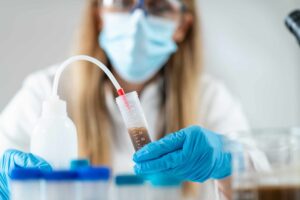What is already known
Vaginal bacteria play important roles in women’s reproductive health. Bacterial vaginosis is a common condition in which the composition of the vaginal microbiota is altered, with fewer lactobacilli and increased levels of Gardnerella and other anaerobic bacteria. Bacterial vaginosis can lead to pregnancy loss, preterm birth and other pregnancy complications, but how exactly an altered vaginal microbiota disrupts vaginal health is unclear.
What this research adds
Researchers analyzed epithelial cells derived from human vaginal specimens, whose surface is covered in protective sugar molecules — called glycans — that come into contact with bacteria and other microbes. The team characterized glycan dynamics in healthy tissues and then studied the impact of resident microbes on the sugars. Ceratin enzymes called sialidases from Gardnerella partially break down glycans on the surface of epithelial cells, generating a bacterial-vaginosis-like state. Treating healthy cells with artificial sialidase enzymes resulted in a bacterial-vaginosis-like state.
Conclusions
The findings suggest that in bacterial vaginosis, certain vaginal microbes disrupt the protective glycans on vaginal epithelial cells, altering processes that mediate cell turnover, death and response to surrounding bacteria.
Bacterial vaginosis is a common vaginal condition associated with a higher risk of health problems, including pregnancy loss and preterm birth. Now, researchers have found that in bacterial vaginosis, certain vaginal microbes disrupt the protective sugars on vaginal epithelial cells, altering processes that mediate cell turnover, death and response to surrounding bacteria.
The findings, published in Science Translational Medicine, may help to explain why bacterial vaginosis is linked to pregnancy complications and other health problems.
Vaginal bacteria play important roles in women’s reproductive health. In bacterial vaginosis, the composition of the vaginal microbiota is altered, with fewer lactobacilli and increased levels of Gardnerella and other anaerobic bacteria. However, how exactly bacterial vaginosis disrupts vaginal health is unclear.
So, researchers led by Kavita Agarwal at the University of California San Diego in La Jolla set out to analyze epithelial cells derived from human vaginal specimens. The surface of these cells is covered in protective sugar molecules — called glycans — that come into contact with bacteria and other microbes.
“We knew that bacterial species implicated in bacterial vaginosis can feed on glycans in secreted mucus,” says study co-author Amanda Lewis. “The current study allowed us to look directly at what those bacteria are then doing to the vaginal epithelial surface landscape on a biochemical and microscopic level.”
Sugar blueprint
The researchers first characterized glycan dynamics in healthy tissues and then studied the impact of resident microbes on the sugars. The data, they say, provide a blueprint for vaginal epithelial glycosylation.
Vaginal bacteria release enzymes called sialidases that break down sialic acids from the glycans on the surface of epithelial cells, the researchers found. This results in a depletion of sialic acids from the vaginal glycans and a reduction of a type of negatively charged glycans on the cells’ surface.
Further experiments showed that Gardnerella sialidase enzymes break down sialic acids from epithelial cells, generating a bacterial-vaginosis-like state. Similarly, treating healthy cells with artificial sialidase enzymes recapitulated some of the features of bacterial vaginosis.
Health complications
“The fact that we were able to replicate some of the effects of bacterial vaginosis suggests that we may be on the right track to finding a common cellular origin for the various complications associated with this condition,” Lewis says.
The findings may also help to improve diagnosing bacterial vaginosis, as differences in glycosylation patterns could help to identify subsets of people who may be at the greatest risk for recurrence or other negative health outcomes, the researchers say.
Although more work is needed to fully understand how bacterial vaginosis affects the many functions of glycans in the vagina, the authors add, the study sheds light on the glycans that decorate vaginal epithelial cells and how these sugars are shaped by resident bacteria.












